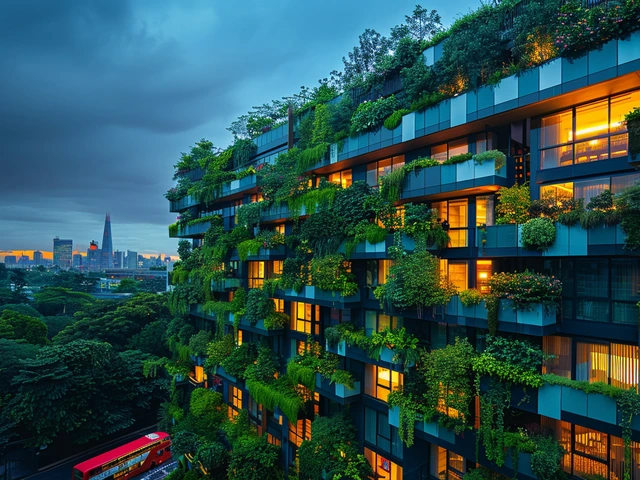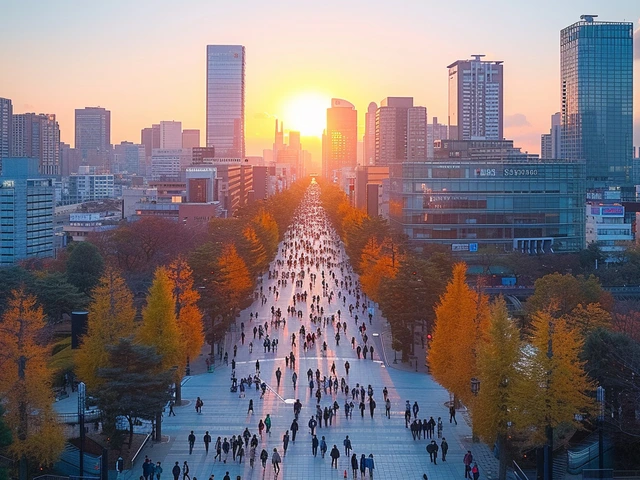If you ever spot a building that looks like it escaped from an abstract art painting, there’s a good chance it’s Constructivist architecture. These structures don’t just sit quietly against the skyline; they shout, gesture, and almost jump into a conversation. The people behind these buildings weren’t just making pretty facades—they were challenging every old idea about what a building should be. The stories behind these pioneers and their groundbreaking works are as wild as the buildings themselves.
What Sparked Constructivist Architecture?
Let’s set the scene: the Russian Revolution had just turned society upside down, and a wave of young architects wasn’t interested in palace replicas or delicate filigrees. They wanted buildings to match their bold, new world. Enter Constructivism, an approach—really, a wild experiment—that exploded around 1920. Instead of focusing on tradition, Constructivists put utility, materials, and daring shapes front and center. Their designs looked more like stage sets for science fiction plays than something your grandma would have lived in.
Everyone talked about how construction should mean production. Factories, sports halls, workers’ clubs, and even housing all took on an industrial edge. Think exposed steel, giant windows, raw concrete, and functional layouts. Instead of hiding how a building stood up, Constructivists flaunted it. This wasn’t about fancy wallpaper or gilded staircases. It was about honest materials and honest function.
The movement found a rocket boost in the chaos and hope of post-revolutionary Russia. Nothing felt settled. Everything felt possible. Inspired by the radical art and posters of people like Malevich and Lissitzky, architects were ready to test limits, and sometimes even common sense, just to see what was possible. These designers leaned heavily on geometry—circles, sharp angles, lines drawn like visual megaphones. It looked electric compared to what came before.
Social goals were always in the design’s DNA. Here, a house wasn’t just a roof and four walls; it might be a mini-commune or a block where strangers mixed and machines set the rhythm. “Form follows function” was cranked up to 11. Everything had a reason to be there, and if it didn’t, it got chopped.
Constructivist ideas didn’t stay locked in Russia. Over time, their rebellious spirit spilled out, sparking architects all over the world to drop the decorative and embrace the daring.
Pioneers Who Defined Constructivist Architecture
Some names in Constructivist history stand out like neon signs. Vladimir Tatlin practically wrote the manual for the movement—even if his most famous building was never actually built. His gigantic “Monument to the Third International” would have made the Eiffel Tower look like a toothpick. It was a swirling, leaning tower that screamed “future!” though the steel for it never actually got off the drawing table.
Then there’s Moisei Ginzburg, who brought Constructivism out of fantasy and into real concrete and brick. Ginzburg’s Narkomfin Building in Moscow is the stuff of architect legend. Imagine apartments designed as “machines for living”—wide open spaces, built-in furniture, communal kitchens, and sunlit walkways. Le Corbusier took notes. Some say it’s the ancestor of almost every experimental housing project that came after.
Another big name, Konstantin Melnikov, was a bit of an outsider—he never joined official collectives, but his style became iconic. His own house, the Melnikov House, is a honeycomb-like cylinder packed with hexagonal windows. It’s as much a sculpture as a home, with spaces that swirl and flow. Unlike some other Constructivist projects, it’s still standing and you can walk through it, proof that wild dreams sometimes can survive time and politics.
There’s also the Vesnin brothers—Leonid, Viktor, and Alexander—who were almost like a rock band of architecture. Their projects included power plants, print shops, and the legendary Palace of Labor (again, never built, but electrifying on paper). Their Palace of Culture for Factory Workers in Moscow was one that actually rose from the ground, standing as a clear gesture to working-class life and the dream of accessible public spaces.
Let’s not skip over El Lissitzky, who blurred every line between artist, architect, and engineer. His “horizontal skyscraper” design in Moscow aimed to float above the city, challenging gravity and everything people thought buildings could do. It bent the rules—it just never made it past the model stage—but its lines and energy still inspire architects who want to break free from the usual boxes.
The Most Daring Constructivist Buildings
Constructivist buildings don’t hide in plain sight—they practically demand you pay attention. Start with the Shukhov Tower in Moscow; designed by Vladimir Shukhov, this 1922 hyperboloid structure looks like a steel whirlpool. It’s breathtaking and ahead of its time. The tower rises almost lightly, twisting and narrowing, challenging the idea that something tall also needs to be bulky.
The Narkomfin Building, mentioned earlier, is often called the “test lab” for modern communal living. Instead of long hallways that felt more like institutional corridors, Ginzburg designed flowing, stacked apartments with shared kitchens and rooftop gardens. It was an early attempt to create a new kind of social life through architecture. The building still stands on Novinsky Boulevard, Moscow, though it’s seen a lot of changes since the original days.
Bakhmetevsky Bus Garage is another classic, built in 1927 by Melnikov and engineer Vladimir Shukhov. Its roof sweeps like a giant wave, with thin steel supports holding up massive skylights. The geometry is bold—form and function hold hands here. It’s not just a storage shed; it’s a showcase for engineering confidence and artistic daring. Today, it’s sometimes used for art exhibitions, which feels almost poetic.
Check out the Rusakov Workers’ Club, another Melnikov creation. With its jutting, block-like halls stretching out like the claws of a mechanical beast, it mirrors the tough, no-nonsense energy of early Soviet culture. Meant to host meetings, lectures, and performances, this building pushed the limits of concrete and brick, and still looks radical a century later.
The Zuev Workers’ Club by Ilya Golosov is all glass and curves. Floor-to-ceiling windows show off the building’s insides—a bold move for the time. It wanted to feel open, democratic, and connected to the life of the city, instead of hiding away behind heavy walls. Picture it: an urban beacon for workers to gather and socialize.
Not every dream made it to real life. Some projects—like Tatlin’s Tower or the Palace of the Soviets—only exist as models or blueprints. But even these paper giants changed the world. Architects everywhere sat up and paid attention, ready to pull off their own experiments with materials and space.
The Social and Political Push Behind Every Wall
Constructivist architecture wasn’t just about looks or new shapes—it was laser-focused on changing society. With the Russian Revolution, the bold idea was that architecture could actually help shape a new way of living. Combine people’s lives in new ways, toss out the old class structures, give folks bright, airy rooms, communal services, and shared spaces. The hope was that the walls around people would shape a new, collective spirit.
Take communal housing, for instance. The Narkomfin Building isn’t just a “machine for living”, it’s a political experiment in everyday life. Central kitchens so you don’t eat alone. Shared roof gardens so neighbors bump into each other. There were whole housing blocks set up so workers could spend less time on chores, more on culture, and more on each other. Lots of the thinking behind modern co-living takes direct inspiration from these bold moves.
Public buildings got their own twist. Clubs, garages, factories—they were all supposed to be democratic spaces, not just walled-off warehouses. The Zuev and Rusakov clubs both wanted glass facades and flexible halls where all sorts of groups could meet. No hierarchical marble pillars here—just easy access and light-filled, inviting rooms.
This push wasn’t all smooth sailing. The Soviet authorities’ vision of Constructivism started to clash with political winds by the 1930s. As Stalin’s rule dug in, architectural tastes drifted back toward heavy-handed classicism and monumental government palaces. Suddenly, marble lions and giant Stalin statues muscled in. But for a wild decade, Constructivists got to rethink social life at every level—from family routines to how entire cities worked. The echoes linger today, especially in places experimenting with communal or low-cost housing strategies.
The Enduring Legacy of Constructivist Architecture
Constructivism, wild and brief as it was, never really went away. Its DNA lives on in the bones of brutalist towers, in the clean lines of glass-and-steel modernism, and in any building that dares to push the rules. Look at Le Corbusier’s early work, the experiments of Bauhaus in Germany, or Oscar Niemeyer’s concrete curves in Brazil—they all took a page, or a whole chapter, from Constructivist architects.
Modern co-working spaces packed with light, open-plan apartments that ditch the stuffy hallway, exposed pipes and beams in tech offices—these all nod to that moment in the 1920s when form followed function with a rebellious twist. Transparency in design, both literal (think glass walls) and social (shared kitchens, open lounges), still feels cutting edge, even a hundred years later.
Some Constructivist landmarks still stand, battered but proud. There's a fresh wave of interest in restoring them. The Narkomfin Building, for example, has been lovingly brought back to life in recent years by architects who wanted to preserve its fresh, functional spirit. The Melnikov House attracts visitors from all over, eager to walk through a place once condemned for being “too strange.”
Want to bring a Constructivist vibe into your own life? Start with the essentials: strip back unnecessary decor, let materials speak, and find clever, functional ways to shape your space. Focus on sunlight, shared spaces, and a hint of industrial chic. Don’t be afraid of bold colors and geometry either. My own kitchen is more Bauhaus than old-school, but a red-and-black Constructivist poster above Baxter’s food bowl always adds a bit of revolution to chow time.
The pioneers of Constructivism didn’t just build with brick, concrete, and steel—they built on hope, shaking off old limits to see what kind of world could be possible. Even if their biggest dreams only ever lived on in drawings, the spirit of daring, honesty, and raw creativity still snaps alive in every risk-taking building put up since. Maybe we don’t all want to live in a communal block, but who doesn’t like a space that feels energetic, useful, and more than a little bit future-facing?



